|
THE STORY
| Conquered Nation
|

Scotland's National Flag, the Saltire or St Andrews Cross © James Gardiner
|
Scotland was left defeated, with no monarch of its own, not even a weakened king. Some tried to become king. Robert, lord of Annandale, (Robert the Bruce's father) made a plea to Edward I for the empty throne. Edward dismissed him with contempt, saying: "Have we nothing else to do but win kingdoms for you?" A sign of his overall contempt for Scotland and its people can be seen in his reported comment to Warenne on leaving the conquered nation in September 1296: "Bon besoiogne fait qy de merde se delivrer" (A man does well to rid himself of waste.)
|
1297 - Year of Uprising
1297 saw sporadic uprisings against the occupying English forces, which were spread across the country. In the north, Andrew Murray (sometimes spelt as Moray) with others such as Alexander Pilche of Inverness mounted major attacks. They captured English-held castles at Inverness, Elgin and Banff. They also besieged Castle Urquhart on Loch Ness. By the end of the summer the Moray district and areas further south were out of English control.
|
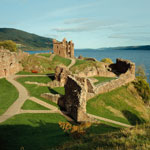
Urquhart Castle ©James Gardiner
|
William Wallace
|
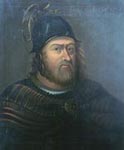
Portrait of Sir William Wallace © Stirling Smith Art Gallery &
Museum
|
It is at this point that William Wallace makes his first
documented appearance in the story of the struggle. However, it is
suggested that he was active before this, and had been an outlawed figure
for a number of years. (One suggestion as to why his name does not appear
on the Ragman Roll of August 1296 is that he was already a figure outside the
law). In 1291 he is believed to have killed an English constable
called Selby (or Selbie) in Dundee. It is also thought that Wallace
killed some English soldiers who demanded his catch of fish at Irvine Water
in 1292. However, it is only from the early summer of 1297 that
proper evidence of his participation in the struggle against the English can be
found.
|
The killing of the English sheriff of Lanark, William Heselrig, remains the critical point in the establishment of Wallace's history and reputation. The story goes that Wallace was surrounded by English soldiers in the middle of Lanark town. The situation eventually erupted into violence and Wallace and his men made their escape through his wife Marion Braidfute's house. When Heselrig attempted to give chase, Braidfute delayed them deliberately, to give Wallace time to get away. However, once the English sheriff had gained access to the house, he killed her on the spot. Wallace returned later that night to exact revenge and killed Heselrig. It was said he cut his body into many pieces, such was the rage that overtook him.
| While the exact reasons behind his actions are mainly unknown, and never will be known, what is known is the effect. Wallace became widely known as the major figure in the rebellion in the southern part of Scotland. He had started with as few as 30 men but this had grown. He had the assistance of Sir William Douglas who helped with a raid on Scone in June 1297, the intention of which was to kill William Ormsby, another of Edward's governors. (Douglas was later to be captured and taken to the Tower of London where he died in 1299. His son, Sir James, was to be a valued leader in Robert the Bruce's army in the later conflicts.) |
Nobles' Uprising
|

Seal of Bishop Robert Wishart © National Museums of Scotland
|
Inspired by the uprisings, Scottish nobles, led by James the Stewart, William Wishart (the Bishop of Glasgow) and the future King, Robert the Bruce, took up arms against the English. However, their attempts were half-hearted and nothing like the determined efforts of Wallace. The rebellion was easily put down at Irvine in July 1297, where the Scots gave in quickly to a stronger English force.
|
Wallace - Leader
Following the Irvine debacle which he was not involved in, Wallace was now the clear leader of the Scottish rebellion in the South. He set up his camp in Selkirk Forest, which stretched as far north as the Forth, before moving north. He went through the counties of Perthshire and Fife, attacking the English wherever possible. He continued northwards to Aberdeen via Dunnottar Castle then west to Buchan and Spey to meet up with Murray and his force. With the north secured, Wallace travelled to Dundee where he laid siege to the castle there.
|
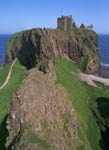
Dunnottar Castle © Historic Scotland
|
The English force who gathered to relieve the English-held castles at Stirling and Dundee was not led by Edward I. The King felt sure his governors would be capable of handling this uprising and had left for France in August. The English force consisted of possibly as many as 10,000 infantry and 300 horse-mounted cavalry. They moved from Berwick to meet what they thought would be an easily defeated Scottish force. The stage was set for a large-scale confrontation and this took place at Stirling Bridge.
September 11th, 1297 - Battle of Stirling Bridge
|

Stirling from Abbey Craig © St Andrews University Library
|
On the eve of the battle, some Scottish nobles had attempted to act as mediators between England and Scotland to secure a Scottish surrender. However, Wallace and Murray were not to be put off and established their position near Abbey Craig, north of the river Forth. Up until now, the Scots had relied on guerrilla warfare tactics, using speed and the element of surprise to attack the enemy. However, at Stirling Bridge, they now faced a typical, medieval, pitched battle.
|
The day of the battle did not start well for the English army. The English commander Warenne, who was in his mid 60s, was still sleeping while his army had started crossing Stirling bridge. It's estimated over 5,000 had crossed the bridge before being recalled to the starting side by the awakened Warenne, who wished to hold a parade of his men. The wooden bridge at Stirling was so narrow only two cavalrymen could cross at one time. This took some time and the English lost the chance of establishing a strong early position over the river.
|

Model of the Battle of Stirling Bridge © Stirling Smith Art Gallery & Museum
|
|
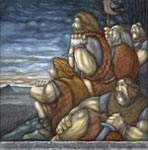
Scottish warriors before the battle © Joan Somerville
|
Later, Warenne sent two friars to the Scots commanders with the message that they should surrender. Wallace and Murray were not ready to do any such thing. Wallace showed his defiance when he replied saying: "Tell your commander that we are not here to make peace but to do battle to defend ourselves and liberate our kingdom. Let them come on and we shall prove this in their very beards."
|
The English, perhaps expecting a pathetic surrender as at Irvine, were now in a quandary. If they stayed where they were, it would resolve nothing. If they crossed the bridge, they would be at a distinct disadvantage as the Scots were already formed up for battle, and would be able to charge them at any time. It was suggested that some of the English cavalry attack from the side, forming a diversion to allow the main body of troops to cross the bridge in relative safety. This was not done. Instead, the vanguard of the force started crossing. Cressingham, the Treasurer of Scotland who had said "There is no point in dragging out this business any longer and wasting our King's revenues for nothing. Let us advance and carry out our duty as we are bound to do" was one of those who crossed the bridge.
|
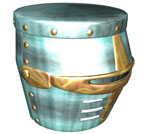
Cavalry helmet © Granite Productions
|
|

Battle of Stirling Bridge, by Owain Kirby © Stirling Smith Art Gallery & Museum |
Wallace and Murray bided their time waiting until just the right moment. Then they played their hand, ordering their men to attack. The Scots infantry made for the bridge, to cut off the English troops' only route in and out of the battlefield. By doing so, they cut off the vanguard from the rest of the English army, who were then forced to watch the ensuing slaughter, which was only a matter of 50 metres away. As the English had crossed onto a causeway surrounded on 3 sides by the river, they had nowhere to retreat but over the bridge, which at some point in the battle was destroyed. They could not be reinforced, nor could they run for safety. |
It's estimated that as many as 5,000 infantry, 300 archers and 100 knights of the English army were killed, either directly in the battle or by drowning trying to cross the river. Hardly any were able to make an escape from the slaughter. Cressingham died as a result of his foolhardy bravery, seemingly not in the glory of battle, but by falling off his horse and being killed by a Scots soldier who could not understand his pleas in French for mercy. Reflecting the barbarity of the times, it is reputed that parts of his skin were sent around Scotland to show he was dead, and that Wallace himself had a belt made of his opponent's skin.
|
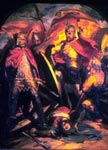
William Wallace planting the Shield of Scotland upon the Body of Cressingham © Paisley Museums & Art Gallery
|
|
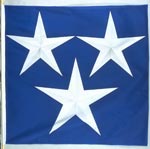
Arms of Sir Andrew Murray © Dr Patrick Barden
|
The battle wasn't decisive in the way that Bannockburn 17 years later would be, but it was still a hugely important victory. Not only had Scotland shown it could defeat the heavy cavalry of the English army but Wallace and Murray had demonstrated their military skills and decision-making prowess. The assured defeat of the English at Stirling Bridge showed them to be most important figures in the rebellion, with the skills and resources to defeat the occupying forces in combat. However, it also had a serious negative effect on the Scottish cause as Murray was fatally wounded during the battle and died 2 months later.
|
Scotland after Stirling Bridge
Despite leading the country to victory, neither Wallace or Murray were officially recognised as the leader of Scotland. However, they still acted in this capacity as can be seen in a letter (sent in October) to the people of Lubeck and Hamburg, advising that Scottish ports were now safe for them to start trading with. The letter was sent by Wallace and Murray who described themselves as the "leaders of the army of the kingdom of Scotland, and the community of that kingdom".
|

Letter to the merchants of Lubeck, 1297 © Stirling Smith Art Gallery & Museum
|
Stirling Surrenders
|
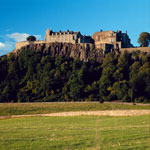
Stirling Castle © James Gardiner
|
After the battle, the action continued. The retreating English army was harassed all the way to the border by the Scots, who showed little mercy to their beaten foes. Stirling Castle soon surrendered to Wallace and Dundee Castle was also taken. By October, only 4 castles remained under English control: Edinburgh, Roxburgh, Berwick and Dunbar. Scotland was now effectively free of English domination. The momentum was kept up by attacking England itself.
|
Border Raids
Border raids were also carried out in the autumn of 1296. However, the purpose of these raids was little more than revenge, retribution and plunder. Northumberland was the target and Berwick, which had been resettled by English was soon taken. The rest of the county was laid to waste, with buildings being burnt and anything of worth being taken back north. Citizens moved to Newcastle for safety from the rampaging Scots. In November, Wallace turned towards the West and Carlisle. After an ineffectual attempt to take the strongly defended castle at Carlisle he turned his attention to Durham. He and his army of just over a 3,000 moved south but were turned back by poor weather and rumours of a strong English force coming to meet them. Mindful of not being away from Scotland for too long in case his absence brough on an attempt to weaken his position, Wallace turned his army northward in November.
|

Carlisle Castle © Peter Nicholson & Peter Armstrong
|
Sir William Wallace
|
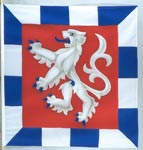
Arms of Sir William Wallace © Dr Patrick Barden
|
William Wallace was knighted sometime between late 1297 and the beginning of 1298. It is possible that Robert the Bruce bestowed this official status on him. During this time, Wallace became the sole Guardian of Scotland as his companion Murray had died in November. He demonstrated his new found power by directing the appointment of bishops, with William Lamberton becoming the Bishop of St Andrews.
|
English Response
The English response to Wallace's impudence was slow to get off the ground. However, a force eventually made its way to Scotland in 1297, travelling from Carlisle to Annandale in the South West. The English troops caused a lot of damage, but it was not until 1298 that a force under the disgraced Warenne made its way north. After relieving Roxburgh and Berwick the English ran out of steam and under Edward's orders were told not to proceed without the King's leadership.
|
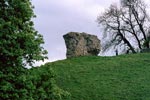
Ruins of Roxburgh Castle © The Rourke Collection
|
Edward I Returns
Edward I returned to England from France in March 1298. He moved quickly, calling for an army to be assembled at York by June. Edward then led his large army (sometimes suggested as being as large as 87,500 men, but probably nearer to 26,000, including 2000 cavalry) into Scotland in July. However, southern Scotland was well prepared for such an invasion and its population had moved out of the army's way, taking with it any provisions that might have fed Edward's army. The King was also relying on supplying his army by ship, which led to some elements starving, notably the Welsh contingent who threatened to swap sides. Edward was as dismissive of them as he was the Scots, saying: "With God's help we shall then defeat the whole lot of them in one go." Wales had given Longshanks much trouble over the years.
|
Confrontation
Wallace did not engage this force preferring to hold off, awaiting a chance for a quick attack like at Stirling Bridge. Frustrated by not having enough provisions for his army and not having faced Wallace's forces, Edward turned back to Edinburgh. Just as it looked like a pitched battle would be avoided, Edward was informed by a spy that the Scots army was at Falkirk, less than 20 miles away, and were ready to attack him in his weak position. The English King took advantage of this situation and on the 22nd July, 1298, marched to confront Wallace.
|
The Battle of Falkirk, 22 July 1298
|
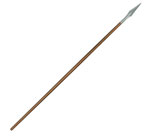
Schiltrom Spear © Granite Productions
|
The exact size of the Scottish army is not known. What is known however, is that it was smaller than Edward's and in the area of mounted cavalry, much the weaker. Wallace arranged his soldiers to defend against the English heavy cavalry assault using the tactic of the "schiltrom" (or schiltron) which was a hedgehog-like arrangement of infantry, two men deep, each with 12 foot long pikes facing outwards. There were 4 schiltroms at Falkirk, each had between 1,000 and 2,000 soldiers in each one. They were intended to injure the horses and men of the cavalry before they could reach the Scots infantry.
|
In between these formations of spearmen, Wallace placed his archers. They were nowhere near as numerous, skilled or deadly as those on the English side. Edward's army used longbows, which would become a very important weapon in medieval battles. Crossbows were also used.
Before the battle, Wallace said to his army these words: "I have brought you to the ring, now see if you can dance."
|
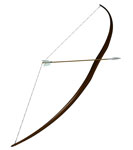
Ettrick Bow © Granite Productions
|
|
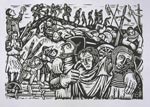
The Battle of Falkirk, by Owain Kirby©Stirling Smith Art Gallery & Museum
|
At the first sign of the English advancing, the Scots cavalry deserted the field. This action, often described by some as treachery and proof that these nobles had been bought off by Edward I, could arguably be attributed to just simple panic at the sight and sound of the approaching English cavalry. Whatever the reason, the effects were disastrous, with no disruption of the English advance or any attack on their archers and crossbowmen.
|
The English cavalry attacked the Scottish archers, decimating them and leaving the schiltroms exposed. The English army's archers then had free reign to pour death onto the Scots. The schiltroms couldn't sustain their strength in the face of such an onslaught. They weakened and when the English cavalry moved in, it was for the kill, and a terrible defeat for Wallace, his army, and the country.
|
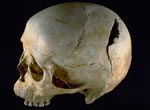
Blade wound from medieval age © Aberdeen City Council
|
|
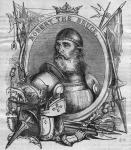
Robert the Bruce © Hulton Getty
|
After an unsuccessful pursuit of Wallace, Edward returned south, leaving Scotland once again a defeated nation. Wallace's time as leader of Scotland was over and he resigned his Guardianship. Whether he was forced to resign or whether he voluntarily stepped down, knowing he could not continue after the defeat at Falkirk is not known. What is known is that he was replaced as leader of Scotland by two men: Robert the Bruce and John Comyn, who were to play their own further parts in the Wars of Independence.
|
|
|







